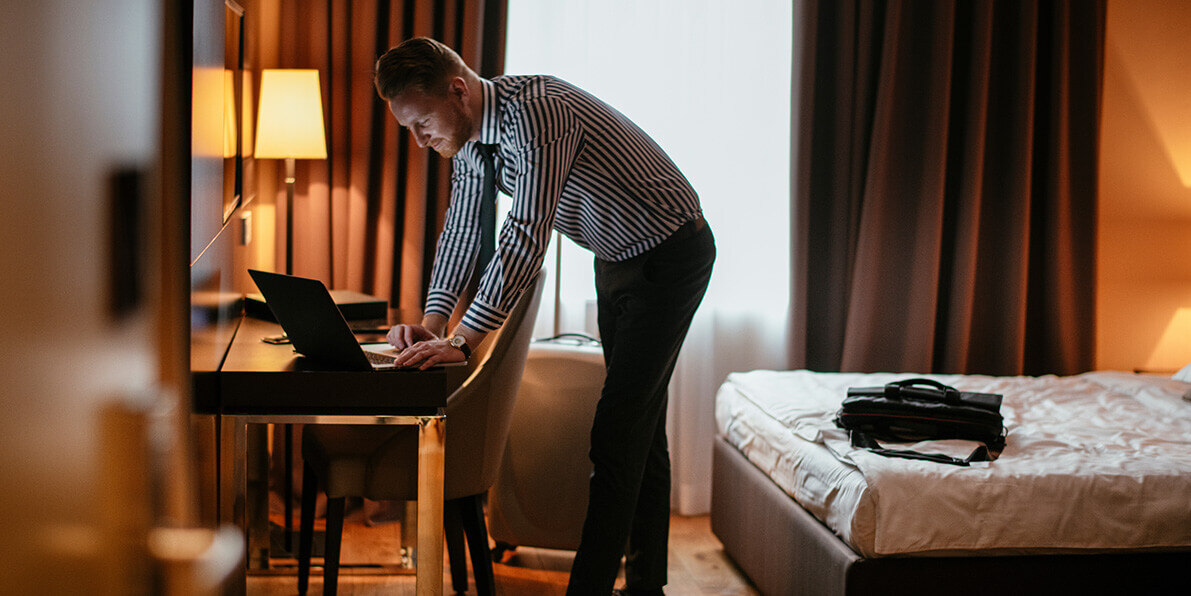Stay service-savvy
Get all the latest news and insights straight to your inbox.

Internet browsing is the new window shopping, with 40% of shoppers going online in-store to check price comparisons, and, when the time comes to pay, 65% do so via the retailer’s app.
In the hospitality sector, a strong network connection can be the deciding factor for whether guests check-in, or out.
9 out of 10 business travellers expect Wi-Fi in their rooms that can cope with their video conferencing and application access needs. For a third of these customers, connectivity is a deal breaker, and without it, they won’t return.
But good connectivity isn’t all your customers want—they also expect personalised experiences.
A modern wireless connectivity provider can help you meet these expectations.
Despite 84% of hotels believing that a reputation for providing good Wi-Fi affects new and repeat business, 43% still offer inflexible wired internet services. Using an ethernet cable might work in a hotel room, but it falls short when your guests want to meet clients or team members in your lounge or conference rooms.
Wireless connectivity is crucial, but it needs to be good.
A weak wireless connection is as damaging as no wireless connection at all, costing the retail sector £3.7bn a year.
The fact is your network connectivity, whether good or bad, has an impact on your customers’ experience. Whether on your premises or interacting with you online, your customers want to experience a seamless connection across all your channels.
Ideally, this seamless connection would be personalised, offering recommendations for products or experiences they might like, as well as discounts and offers.
In fact, two-thirds of customers are willing to pay more to get personalised experiences. And almost half of hotel guests are more likely to return if their stay felt tailored.
But if you can’t offer personalisation you’re likely to lose customers, as nearly three-quarters of consumers feel frustrated when a shopping experience is impersonal.
Wireless connectivity providers are well positioned to ensure you meet these expectations as they typically have integrated AI and machine learning capabilities that can analyse data and provide customer insights.
With these insights, you can create the tailored experiences your customers expect.
Wireless connectivity is cost-effective because it helps you retain, and gain customers.
Customers want access to free Wi-Fi, nearly three-quarters of hotel guests base their booking decision on it, but free doesn’t mean bad value for you.
Free and good Wi-Fi encourages customers to stay at your premises for longer, increasing their spending with you, as two-thirds of businesses in the hospitality sector have already found.
Customers are aware that free Wi-Fi usually requires a data exchange, and three-quarters of them will happily give you their email addresses so that they can access the connectivity they want. With this information, you can generate further revenue through marketing channels and personalisation.
Finally, wireless connectivity is cheaper to install and expand than wired networks. So, once you’ve got it, you can easily scale the network based on demand without needing to add new wires.
The cost-effectiveness of wireless connectivity is especially important considering the new payroll and business rate costs the hospitality sector now needs to contend with.
While overhauling your connectivity offering may seem like a big task, upgrading your network provider will be more cost-effective for you in the long run, helping you to secure customer loyalty now and into the future and simultaneously boosting your business revenue.
Join us on this exciting journey as we drive the future of wireless connectivity. We empower businesses to embrace the full potential of wireless technology and leverage its advantages to achieve unprecedented success. Together, we are shaping a world where seamless and innovative wireless connectivity paves the way for unparalleled opportunities and transformative growth.
To find out more about how a wireless provider can help boost your sales, get in touch with our team today, and we’ll be happy to help.
Networking & Connectivity, Wireless connectivity, Extreme, Hospitality, Retail
Get all the latest news and insights straight to your inbox.